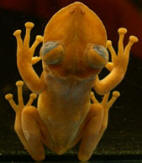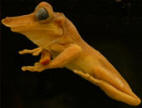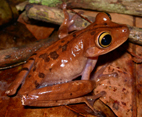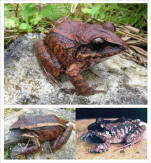Cruz, C. A. G.; M. F. Napoli & P. M.
Fonseca. 2008. A new species of Phasmahyla
Cruz, 1990 (Anura: Hylidae) from the
State of Bahia, Brazil. South American Journal of
Herpetology, 3(3):187–195.
|

Phasmahyla timbo
|
Abstract.
A new species of the genus Phasmahyla is described
from an Atlantic Rain Forest remnant at Serra do Timbó,
Municipality of Amargosa, State of Bahia, Brazil. The new
species is recognized by its medium size for the genus (snout-vent
length 32.4 to 35.8 mm in males); reduced to absent
coloration with purple spots on concealed surfaces of arm,
forearm, thigh, tibia, tarsus, and digits; male with
moderate nuptial pad of minuscule horny asperities on finger
I; tympanum distinct only on ventral half; dorsolateral
glands well developed; dorsal skin slightly coarse; larval
oral disc with distinct anterior and two posterior series of
horny teeth; interrupted first posterior series of horny
teeth slightly larger than the anterior one. Temporal and
spectral parameters of the advertisement call are described
for the new species, and for the first time for the genus
Phasmahyla.

|
Pimenta,
B. V.; M. F. Napoli & C. F. B.
Haddad. 2009. A new species of casque-headed tree
frog, genus Aparasphenodon Miranda-Ribeiro (Amphibia:
Anura: Hylidae), from the Atlantic Rainforest of southern
Bahia, Brazil.
Zootaxa, 2123:46–54.
|


Aparasphenodon arapapa
|
Abstract.
A new species of Aparasphenodon is described from
patches of arboreal restinga within the Atlantic Forest
Biome, in a region known as Baixo Sul in southern Bahia,
northeastern Brazil. Aparasphenodon arapapa sp.
nov. is promptly diagnosed from other Aparasphenodon
mainly by having small size (male snout-vent length
57.4–58.1 mm), loreal region flattened and wide, and canthus
rostralis rounded and poorly elevated. The wide and
flattened snout resembles that found in Triprion and
Diaglena, and possibly is a parallelism (homoplasy)
related to the phragmotic behavior of casque-headed tree
frogs to their microhabitat usage. The decision to allocate
the new species in the genus Aparasphenodon is
discussed in detail, as the single morphological
synapomorphy of the genus, the presence of a prenasal bone,
is insufficient to morphologically relate the new species to
Aparasphenodon, Triprion, or Diaglena.
Resumo.
Uma nova espécie de Aparasphenodon é descrita,
proveniente de fragmentos de restinga situados no Bioma da
Floresta Atlântica, em uma região conhecida como Baixo Sul
no sul da Bahia, nordeste do Brasil. Aparasphenodon
arapapa sp. nov. é prontamente diagnosticada de
outros Aparasphenodon principalmente por apresentar
tamanho pequeno (comprimento rostro-cloacal em machos
57,4–58,1 mm), região loreal achatada e larga e canto
rostral levemente arredondado e pouco elevado. O focinho
largo e achatado se assemelha aos de Triprion e
Diaglena e possivelmente é um paralelismo (homoplasia)
relacionado ao comportamento de fragmose praticado por
pererecas-de-capacete no uso de seus micro-hábitats. A
decisão de alocar a nova espécie no gênero Aparasphenodon
é discutida em detalhe, já que a única sinapomorfia
morfológica de Aparasphenodon, a presença de um osso
prenasal, é insuficiente para relacionar morfologicamente a
nova espécie a Aparasphenodon, Triprion ou
Diaglena.
|
Napoli, M. F.; Ananias, F.; Fonseca, P. M.; Silva, A. P. Z.
2009.
Morphological and karyotypic contributions for a better
taxonomic definition of the frog Ischnocnema ramagii
(Boulenger, 1888) (Anura, Brachycephalidae).
South American Journal of Herpetology,
4(2):164–172.
|

Ischnocnema ramagii
(Salvador, Bahia)
|
Abstract.
In this
study we describe the morphological variation of
Ischnocnema ramagii from a
population sample within the Municipality of Salvador, Bahia
State, Brazil, and characterize two extremely distinct
morphotypes within this taxon (striped vs. non-striped
dorsum); we describe its karyotype, and compare the
karyotypic structure of the distinct morphotypes recognized
herein. Specimens with striped dorsa were less common (13-18%)
than those with non-striped dorsa (81-86%),
the latter group comprising a mix of discrete color pattern
states, whose frequencies were not different among
juveniles, males, and females. The PCAs on morphometric data
resulted in a strong degree of superposition between striped
and non-striped dorsa, for both genders. We encountered a
diploid number of 30 chromosomes for both males and females,
with chromosome pairs 1 to 15 being telocentric. The
karyotypic comparison between specimens with striped and
non-striped dorsa did not show any noticeable difference.
Nevertheless the karyotype of
I. ramagii from Salvador, Bahia, differed from the
karyotype described for
I. paulodutrai
from Ilhéus, Bahia, which showed a
submetacentric chromosome pair. This result supports the
presence of two full "sibling" species in Bahia State, one
from the south (I.
paulodutrai) and
another from the north (I.
ramagii),
validating the identity of
I. paulodutrai
as a full species, and refuting the
recognition of Salvador samples as
I. paulodutrai.
The high number of telocentric
chromosomes suggests a closer relationship between
I. ramagii
and
"Eleutherodactylinae"
species from Central America and the
northern region of Brazil.
|
Napoli, M. F.; Pimenta, B. V. S.
2009. A new species of the
Bokermannohyla circumdata group (Anura:
Hylidae) from the coastal forests of Bahia, northeastern
Brazil.
Copeia,
2009(4):674–683.
|

Bokermannohyla capra
(Amargosa, Bahia)
|
Abstract.
We
describe a new species of tree frog related to the
Bokermannohyla circumdata
group, the northernmost record from
Atlantic Forest remnants in eastern Bahia, northeastern
Brazil, within regions known as Vale do Jiquiriçá, Baixo
Sul, and Litoral Sul. The new species is diagnosed by medium
size (snout–vent length 46.8–64.1 mm), head longer than wide,
small tympanum, posterior surfaces of thighs with dark brown
transverse stripes without additional thin stripes between
them, vocal slits in adult males, and distinct advertisement
call with a single note composed of 30–110 pulses
distributed within 2–9 pulse groups, similar to the bleating
of a goat. The new species is morphologically similar to
B. hylax
and
B.
lucianae, but is readily distinguished by the presence
of barred posterior surfaces on the thighs without thin
stripes between them (immaculate in B. lucianae;
thin stripes intercalated with wider stripes in
B. hylax)
and by its distinct vocalization.

|
| Napoli, M. F.;
Juncá, F. A.; Cruz, D.; Abreu, R. O. 2010. Amphibia,
Anura, Strabomantidae, Strabomantis aramunha
Cassimiro, Verdade & Rodrigues, 2008: Distribution
extension with notes on natural history, color
patterns, and morphometric data. Check List (São
Paulo. Online),
v. 6, p. 275–279.
|
|

Strabomantis aramunha |
Abstract.
During surveys of anurans in the Chapada Diamantina,
a semiarid region in central Bahia, Brazil, we obtained new
records of
Strabomantis aramunha
Cassimiro, Verdade and
Rodrigues. The new records extend the geographic
distribution of
S. aramunha
in
about 200 km north and 75 km south in relation to the type
locality (municipality of Mucugê, state of Bahia, Brazil).
We observed males calling at night at the Morro do Pai
Inácio, municipality of Palmeiras. This new data is
important, as in the original description the authors
suggested the possibility of absence of advertisement call
in the species. We also provide additions on color and
morphometric data.

|
| Cruz, C. A. G.;
Napoli, M. F. 2010. A new species of smooth horned
frog, genus Proceratophrys
Miranda-Ribeiro
(Amphibia: Anura: Cycloramphidae), from the Atlantic
Rainforest of eastern Bahia, Brazil.
Zootaxa 2660:
57–67. |
|

Proceratophrys sanctaritae sp.
nov. |
Abstract.
We describe a new species of smooth
horned frog related to the
Proceratophrys appendiculata
complex,
constituting the northernmost record of that complex for the
Atlantic Forest remnants in eastern Bahia, northeastern
Brazil, within a region known as Vale do Jiquiriçá.
Proceratophrys sanctaritae sp.
nov. is diagnosed from all
congeners by the combination of medium size (snout–vent
length 38.4–45.5 mm), single and long uni-cuspidate
palpebral appendage, rostral appendage longer than upper lip
width, presence of preocular crest, frontoparietal crest
poorly developed, color of ventral surfaces, and acoustic
parameters of the advertisement call.

|






